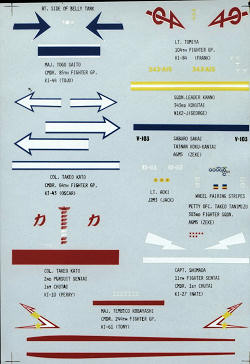 Having a number of WW2 era
Japanese fighters in my store of unbuilt kits I decided to acquire this decal
sheet to enable me to complete some of them as the aircraft flown by the aces of
WW2 as is my preferred theme for my fighter collection.
Having a number of WW2 era
Japanese fighters in my store of unbuilt kits I decided to acquire this decal
sheet to enable me to complete some of them as the aircraft flown by the aces of
WW2 as is my preferred theme for my fighter collection.|
SHEET: |
Superscale 72-067 WW2 Japanese Aces |
|
PRICE: |
$ |
|
UNITS: |
See review |
|
REVIEW & |
Brendan Ibbs |
|
NOTES: |
A very old sheet and one of Microscale/Superscale's earliest offerings. |
 Having a number of WW2 era
Japanese fighters in my store of unbuilt kits I decided to acquire this decal
sheet to enable me to complete some of them as the aircraft flown by the aces of
WW2 as is my preferred theme for my fighter collection.
Having a number of WW2 era
Japanese fighters in my store of unbuilt kits I decided to acquire this decal
sheet to enable me to complete some of them as the aircraft flown by the aces of
WW2 as is my preferred theme for my fighter collection.
Upon receiving the sheet I discovered that while it lists the aircraft type and name of the pilot, there is no profile artwork provided of the aircraft concerned and no information whatsoever about the correct location for the markings on the sheet.
Therefore it falls to the purchaser to do some
research and hopefully locate the required information, which is what I’ve done,
with varying degrees of success.
In technical terms, the decals appear to be in good register and sharply printed. (For those who wish to see the other two Japanese tail markings sheets in this series, please visit this review. It should be noted that when Microscale - later Superscale- first started printing decals, they expected the builder to have access to the easily obtained and rather inexpensive references of the day. Ed)
The markings are not numbered as such, so the descriptins of the planes and pilots to follow will be done starting at the top left and working down , then moving to the right side and finishing with the bottom set of markings.
 Ki-44 II Otsu flown by the commanding officer of the 85th
Sentai, Major Togo Saito while at Canton, China in 1944.
Ki-44 II Otsu flown by the commanding officer of the 85th
Sentai, Major Togo Saito while at Canton, China in 1944.
Searching the net produced a
color profile of Saito’s Ki-44 , allied codename “Tojo” which appears to have
green upper surfaces with black anti glare panel, pale grey undersides, with the
white edged blue arrow on the tail and white edge blue band around the rear
fuselage.
Togo Saito does not appear
on the list of aces provided in Ospery’s
Japanese Army
Air Force Aces 1937-45
or many of the lists of
Japanese
Aces available on the internet. One such list that does contain Togo Saito is;

The Oscar in the attached
profile contains a blue edged white arrow on the tail and similarly colored
bands on the fuselage. The decal sheet doesn’t contain the fuselage bands and
contains a second set of arrows that don’t appear on the attached profile.
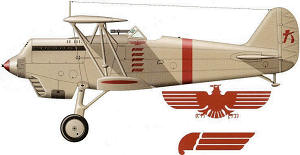
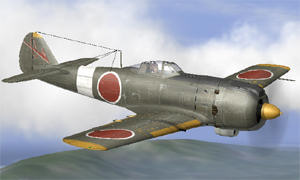
The only image I was able to
find of, supposedly, Tomiya’s Ki-84 is attached and contains the same tail
markings provided on the Superscale sheet. There is no indication as to where
the three victory markings contained on Superscale’s sheet might be placed.
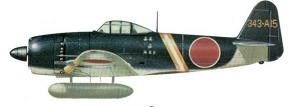

Saboru Sakai, probably the
most well known WW2 Japanese ace, reportedly flew the Zero coded V-103 shown in
the attached profile, matching the markings provided on the decal sheet. The
Tainan Koku-Kantai was based in

A curious choice to include
on the sheet for two reasons,
firstly the readily available Hasegawa 1/72 Jack/Raiden kit already contains
markings for a J2M flown by Lt Yoshihiro Aoki and secondly because Aoki does not
appear on any list of Japanese aces that I could find.
Given these two factors I
would’ve preferred to see markings for Lt Sadaaki Akamatsu’s J2M, Akamatsu being
credited with 27+ victories.
A number of slightly
differing profiles of Aoki’s J2M are available on the net, containing the
distinctive yellow lightning bolt markings which are not included on the
Superscale sheet but are contained with the aforementioned Hasegawa kit.
The serial number on the tail differs
from what is included on the sheet and the three cherry blossom (?) symbols on
the decal sheet, likely representing victories or probables, are not visible on
any profile I could find. The Superscale sheet’s “3D-153” may have been a less
well known mount of Aoki’s at some stage.

Takeo Tanimizu flew an A6M5
with the 303rd hikotai, 203rd kokutai in
The markings in the attached
profile closely match that on the Superscale sheet, though the color of the
serial number differs.
Tanimizu is credited with 32
victories in Osprey’s Imperial Japanese
Navy Aces 137-45
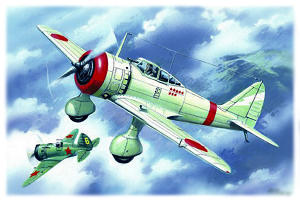 Ki-27 Nate flown by Captain Shimada, 11 Fighter Sentai, 1st
Chutai
Ki-27 Nate flown by Captain Shimada, 11 Fighter Sentai, 1st
Chutai
Kenji Shimada flew the Ki-27
Nate pictured in the attached illustration, from the ICM kit, in
The markings on the
Superscale sheet match those in the picture with the exception of the band
around the rear fuselage which is white on the sheet but red in the picture.
 Ki-61 ‘Tony’ flown by Tembico Kobayashi, Commander, 244th
fighter group.
Ki-61 ‘Tony’ flown by Tembico Kobayashi, Commander, 244th
fighter group.
Kobayashi is the most well
known proponent of the Ki-61, flying a number of different examples, usually
adorned with kill markings depicting his successes over B-29s, including one
brought down by ramming.
Kobayashi is generally
credited with between 5 and 12 victories.
The closest profile I could
find to match the markings on the Superscale sheet is actually from a Life Like
Decals sheet and is shown below. There appear to be some differences in the
victory markings and the colors of the tail marking however.
From the Life Like decals
description;
“…Ki-61 Type I-Tei #4424
flown by Capt. Teruhiko Kobayashi, Commander of the 244th Sentai, Chofu Airbase,
June 2009
If you would like your product reviewed fairly and quickly, please contact me or see other details in the Note to Contributors.